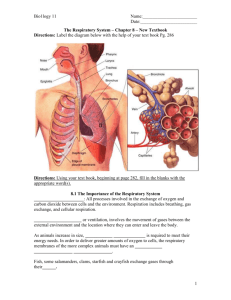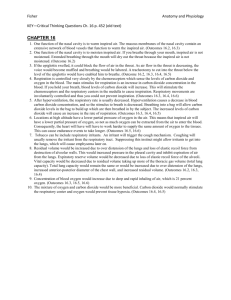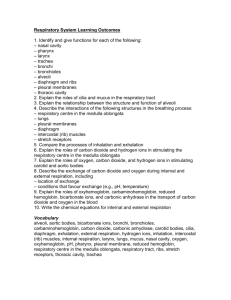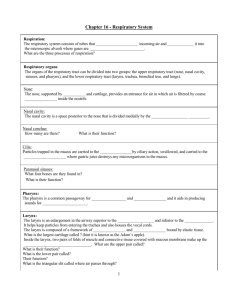I. Introduction
advertisement
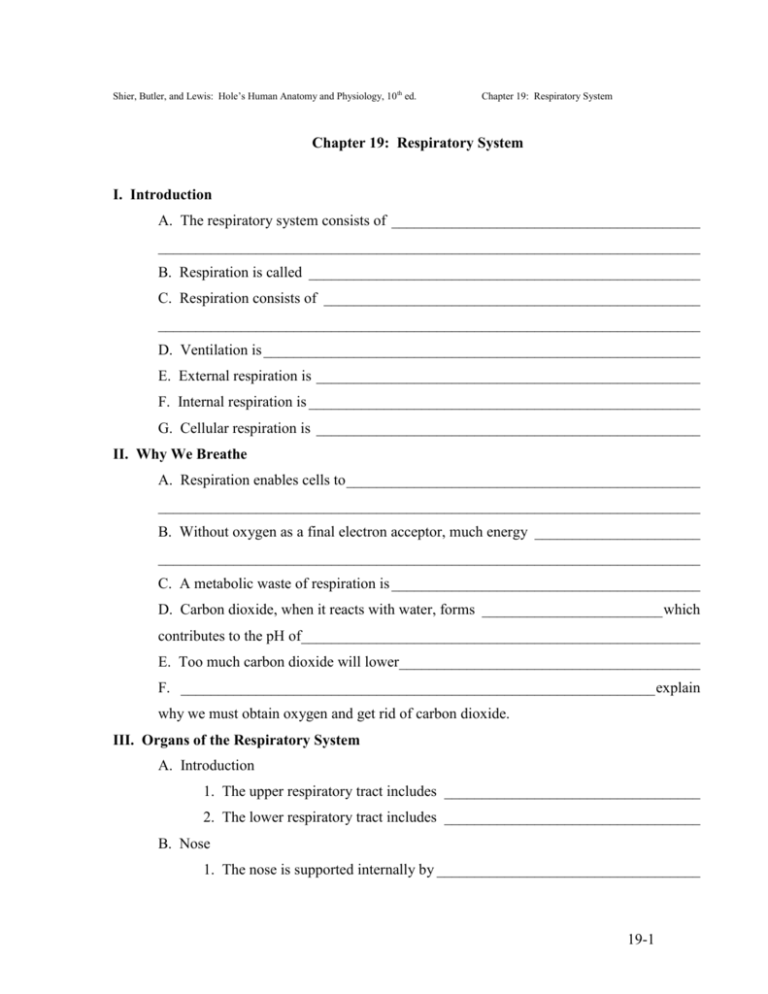
Shier, Butler, and Lewis: Hole’s Human Anatomy and Physiology, 10 th ed. Chapter 19: Respiratory System Chapter 19: Respiratory System I. Introduction A. The respiratory system consists of _________________________________________ ________________________________________________________________________ B. Respiration is called ____________________________________________________ C. Respiration consists of __________________________________________________ ________________________________________________________________________ D. Ventilation is __________________________________________________________ E. External respiration is ___________________________________________________ F. Internal respiration is ____________________________________________________ G. Cellular respiration is ___________________________________________________ II. Why We Breathe A. Respiration enables cells to _______________________________________________ ________________________________________________________________________ B. Without oxygen as a final electron acceptor, much energy ______________________ ________________________________________________________________________ C. A metabolic waste of respiration is _________________________________________ D. Carbon dioxide, when it reacts with water, forms ________________________ which contributes to the pH of_____________________________________________________ E. Too much carbon dioxide will lower________________________________________ F. _______________________________________________________________ explain why we must obtain oxygen and get rid of carbon dioxide. III. Organs of the Respiratory System A. Introduction 1. The upper respiratory tract includes __________________________________ 2. The lower respiratory tract includes __________________________________ B. Nose 1. The nose is supported internally by ___________________________________ 19-1 2. Nostrils are ______________________________________________________ 3. Internal hairs of nostrils prevent _____________________________________ __________________________________________________________________ C. Nasal Cavity 1. The nasal cavity is ________________________________________________ 2. The nasal septum is _______________________________________________ 3. The nasal cavity is separated from the cranial cavity by ___________________ ___________________ and from the oral cavity by _______________________ 4. Nasal conchae are located _______________________________________ and divide the nasal cavity into ____________________________________________ 5. Nasal conchae function to __________________________________________ __________________________________________________________________ 6. The lining of the upper portion of the nasal cavity contains ________________ __________________________________________________________________ 7. Most of the nasal cavity conducts air __________________________________ 8. The mucous membrane lining the nasal cavity contains ___________________ __________________________________________________________________ 9. The functions of the mucous membrane of the nasal cavity are _____________ __________________________________________________________________ 10. Cilia of the nasal cavity function to __________________________________ __________________________________________________________________ D. Sinuses 1. Sinuses are ______________________________________________________ 2. Bones that contain sinuses are _______________________________________ __________________________________________________________________ 3. The functions of sinuses are _________________________________________ __________________________________________________________________ E. Pharynx 1. The pharynx is located _____________________________________________ __________________________________________________________________ 19-2 2. Functions of the pharynx are ________________________________________ __________________________________________________________________ F. Larynx 1. The larynx is ____________________________________________________ __________________________________________________________________ 2. The functions of the larynx are ______________________________________ __________________________________________________________________ 3. The larynx is composed of __________________________________________ __________________________________________________________________ 4. The cartilages of the larynx are ______________________________________ 5. The thyroid cartilage is located ______________________________________ 6. The cricoid cartilage is located ______________________________________ 7. The epiglottic cartilage is located ____________________________________ __________________________________________________________________ 8. The epiglottis is __________________________________________________ 9. The functions of the epiglottis are ____________________________________ __________________________________________________________________ 10. The arytenoid cartilages are located _________________________________ 11. The corniculate cartilages are located ________________________________ 12. The arytenoids and corniculate cartilages are attachment sites for __________ __________________________________________________________________ 13. The cuneiform cartilages are located _________________________________ and function to _____________________________________________________ 14. False vocal cords are located ____________________________________ and are composed of ____________________________________________________ 15. The function of the false vocal cords is _______________________________ __________________________________________________________________ 16. The true vocal cords are located _________________________________ and are composed of ____________________________________________________ 17. The functions of the true vocal cords are ______________________________ __________________________________________________________________ 19-3 18. A higher pitch of the voice is produced by ____________________________ and a lower pitch is produced by _______________________________________ 19. The loudness of a vocal sound depends on ____________________________ __________________________________________________________________ 20. The glottis is____________________________________________________ 21. The mucous membrane that lines the larynx continues to filter incoming air by __________________________________________________________________ __________________________________________________________________ G. Trachea 1. The trachea is _________________________________________________ and is located __________________________________________________________ 2. The trachea splits into _____________________________________________ 3. The inner wall of the trachea is lined with ______________________________ __________________________________________________________________ 4. The mucous membrane of the trachea functions to _______________________ __________________________________________________________________ 5. The wall of the trachea is composed of ________________________________ __________________________________________________________________ 6. The cartilaginous rings of the trachea prevent ___________________________ __________________________________________________________________ 7. The soft tissues that complete the rings in the back of the trachea allow ______ __________________________________________________________________ 8. A blocked trachea causes ___________________________________________ 9. A tracheostomy is ________________________________________________ H. Bronchial Tree 1. Introduction a. The bronchial tree consists of _________________________________ ____________________________________________________________ b. Primary bronchi are _________________________________________ c. The carina is _______________________________________________ 19-4 d. Each bronchus, accompanied by ______________________________ , enters its respective lung. 2. Branches of the Bronchial Tree a. Primary bronchi branch into___________________________________ b. Secondary bronchi branch into ________________________________ c. Tertiary bronchi branch into___________________________________ d. A bronchopulmonary segment is _______________________________ e. Intralobular bronchioles branch into ____________________________ f. Terminal bronchioles branch into _______________________________ g. Respiratory bronchioles branch into ____________________________ h. Alveolar ducts give rise to ____________________________________ i. Alveolar sacs are ____________________________________________ j. Alveoli are_________________________________________________ 3. Structure of the Respiratory Tubes a. The structure of a bronchus is similar to that of the trachea except _____ ____________________________________________________________ b. Finer branches of the respiratory tree have decreased amounts of _____ __________________ and increased amounts of ____________________ c. ________________________ fibers are scattered throughout the lungs. d. Other changes in the tubes of the respiratory tree as they get smaller are ____________________________________________________________ ____________________________________________________________ 4. Functions of the Respiratory Tubes and Alveoli a. The branches of the bronchial tree function to_____________________ ____________________________________________________________ b. The alveoli function to _______________________________________ ____________________________________________________________ I. Lungs 1. The lungs are _____________ shaped and located _______________________ 2. The right and left lungs are separated by _______________________________ ______________ and enclosed by _____________________________________ 19-5 3. The hilus of the lung is_____________________________________________ 4. Visceral pleura is _________________________________________________ 5. Parietal pleura is __________________________________________________ 6. The pleural cavity is _______________________________________________ 7. The functions of serous fluid in the pleural cavity are_____________________ __________________________________________________________________ 8. The lobes of the right lung are _______________________________________ 9. The lobes of the left lung are ________________________________________ 10. Lobules of the lungs are ___________________________________________ IV. Breathing Mechanism A. Introduction 1. Breathing or ventilation is __________________________________________ 2. Inspiration is_____________________________________________________ 3. Expiration is _____________________________________________________ B. Inspiration 1. The force that moves air into the lungs is ______________________________ 2. If the pressure inside the lungs and alveoli decreases, outside air will ________ __________________________________________________________________ 3. The diaphragm is located ________________________________________ and is composed of _____________________________________________________ 4. The nerves that stimulate the diaphragm are ____________________________ 5. When the diaphragm contracts it moves ____________________________ and the thoracic cavity ___________________________________________________ 6. When the thoracic cavity enlarges, the intra-alveolar pressure ______________ 7. When intra-alveolar pressure falls, air is _______________________________ 8. The action of external intercostals muscles is ___________________________ _________________________ which _________________________ the size of the thoracic cavity. 9. When intercostals muscles move the thoracic wall upward and outward, the ________________________ and ________________________________ move. 19-6 10. Movement of the parietal and visceral pleura upward and outward expands __________________________________________________________________ 11. Surface tension is ________________________________________________ 12. Surfactant is located ___________________________________________ and functions to ________________________________________________________ 13. If a person needs to take a deeper than normal breath, the diaphragm and external intercostals muscles___________________________________________ 14. Other muscles that can be used to enlarge the thoracic cavity are ___________ __________________________________________________________________ 15. Compliance is___________________________________________________ 16. In a normal lung, compliance__________________________ as lung volume increases because ___________________________________________________ __________________________________________________________________ 17. Factors that lead to a decrease in lung compliance are ___________________ __________________________________________________________________ C. Expiration 1. The forces responsible for normal expiration come from __________________ __________________________________________________________________ 2. As the diaphragm and external intercostals muscles relax, the elastic tissues cause the lungs to ___________________________________________________ 3. Air is forced out of respiratory passageways because _____________________ __________________________________________________________________ 4. Muscles that aid in a more forceful exhalation than normal are _____________ __________________________________________________________________ D. Respiratory Volumes and Capacities 1. Spirometry is ____________________________________________________ 2. A respiratory cycle is ______________________________________________ 3. Tidal volume is __________________________________________________ 4. Inspiratory reserve volume is ________________________________________ 5. Expiratory reserve volume is ________________________________________ 6. Residual volume is ________________________________________________ 19-7 7. Vital capacity is __________________________________________________ 8. Inspiratory capacity is _____________________________________________ 9. Functional residual capacity is _______________________________________ 10. Total lung capacity is _____________________________________________ 11. Anatomic dead space is ___________________________________________ 12. Alveolar dead space is ____________________________________________ 13. Physiologic dead space is__________________________________________ 14. A spirometer measures ____________________________________________ 15. Respiratory volumes and capacities are used to evaluate _________________ __________________________________________________________________ E. Alveolar Ventilation 1. Minute ventilation is ___________________________________________ and equals ____________________________________________________________ 2. The volume of air that reaches alveoli is calculated by ____________________ __________________________________________________________________ 3. Alveolar ventilation rate is _______________________________________ and is a major factor affecting _____________________________________________ F. Nonrespiratory Air Movements 1. Nonrespiratory air movements are ____________________________________ 2. Examples of nonrespiratory air movements are__________________________ __________________________________________________________________ 3. Nonrespiratory air movements usually result from _______________________ __________________________________________________________________ 4. Coughing involves ________________________________________________ __________________________________________________________________ 5. The function of a sneeze is__________________________________________ 6. Laughing involves ________________________________________________ __________________________________________________________________ 7. A hiccup is caused by _____________________________________________ __________________________________________________________________ 19-8 8. The function of a yawn is___________________________________________ __________________________________________________________________ V. Control of Breathing A. Respiratory Center 1. The respiratory center is____________________________________________ 2. The functions of the respiratory center are _____________________________ __________________________________________________________________ 3. The components for the respiratory center are located ____________________ __________________________________________________________________ 4. The medullary rhythmicity includes __________________________________ __________________________________________________________________ 5. The dorsal respiratory group is responsible for __________________________ __________________________________________________________________ 6. The functions of the ventral respiratory center are _______________________ __________________________________________________________________ 7. The functions of the pneumotaxic area are _____________________________ __________________________________________________________________ B. Factors Affecting Breathing 1. Partial pressure of a gas is __________________________________________ __________________________________________________________________ 2. High concentrations of carbon dioxide in blood are detected by_____________ __________________________________________________________________ 3. In response to high carbon dioxide levels, the respiratory center triggers______ __________________________________ in alveolar ventilation, which decreases __________________________________________________________ in blood. 4. High concentrations of hydrogen ions in blood or cerebrospinal fluid are detected by ________________________________________________________ 5. In response to high hydrogen ion levels, the respiratory center triggers _______ __________________________________ in alveolar ventilation, which decreases __________________________________________________________ in blood. 19-9 6. Low concentrations of oxygen in blood are detected by ___________________ __________________________________________________________________ 7. When blood levels of oxygen are low, ventilation ____________________ and the concentration of oxygen in blood ____________________________________ 8. The inflation reflex helps regulate ____________________________________ __________________________________________________________________ 9. The inflation reflex occurs when _____________________________________ __________________________________________________________________ 10. The inflation reflects prevents ______________________________________ __________________________________________________________________ 11. Hyperventilation is ____________________________________________ and it lowers ___________________________________________________________ VII. Alveolar Gas Exchanges A. Alveoli 1. Alveoli are ______________________________________________________ __________________________________________________________________ 2. An alveolus consists of ____________________________________________ __________________________________________________________________ 3. Alveolar pores are ________________________________________________ __________________________________________________________________ 4. Alveolar macrophages are _______________________________________ and function to _________________________________________________________ B. Respiratory Membrane 1. The respiratory membrane is composed of _____________________________ __________________________________________________________________ 2. The respiratory membrane is the site of ________________________________ __________________________________________________________________ C. Diffusion Through the Respiratory Membrane 1. Molecules diffuse from ____________________________________________ __________________________________________________________________ 19-10 2. Carbon dioxide diffuses from blood in pulmonary capillaries to alveolar air because ___________________________________________________________ __________________________________________________________________ 3. Oxygen diffuses from alveolar air to blood in pulmonary capillaries because __________________________________________________________________ 4. Factors that affect diffusion across the respiratory membrane are ___________ __________________________________________________________________ 5. Diseases that harm respiratory membranes are __________________________ __________________________________________________________________ 6. Breath analysis can detect alcohol in the blood because ___________________ __________________________________________________________________ VIII. Gas Transport A. Introduction 1. The blood transports oxygen and carbon dioxide between _________________ __________________________________________________________________ 2. As oxygen and carbon dioxide enter blood, they _________________________ __________________________________________________________________ B. Oxygen Transport 1. Almost all the oxygen carried in blood is bound to _______________________ 2. A small amount of oxygen is carried in blood dissolved ___________________ 3. Hemoglobin consists of ____________________________________________ 4. Each heme group contains an _______________________________________ 5. Oxyhemoglobin is ________________________________________________ 6. Deoxyhemoglobin is ______________________________________________ 7. Factors that promote the release of oxygen from hemoglobin are ____________ __________________________________________________________________ C. Carbon Dioxide Transport 1. Blood flowing through capillaries gains carbon dioxide because ____________ __________________________________________________________________ 2. Carbon dioxide is transported to lungs in one of the following three forms: ___ __________________________________________________________________ 19-11 3. Carbaminohemoglobin is ___________________________________________ __________________________________________________________________ 4. Hemoglobin can carry oxygen and carbon dioxide at the same time because __________________________________________________________________ 5. The most important carbon dioxide transport mechanism involves __________ __________________________________________________________________ 6. Carbon dioxide forms ________________________ when it reacts with water. 7. Carbonic anhydrase is __________________________________________ and is located __________________________________________________________ 8. Carbonic acid dissociates into _______________________________________ 9. The chloride shift is ____________________________________________ and functions to ________________________________________________________ 10. When blood reaches the pulmonary capillaries, ________________________ _____________________ recombine to form ____________________________ 11. In the pulmonary capillaries, carbonic acid becomes _____________________ __________________________________________________________________ 12. In the lungs, carbon dioxide diffuses _________________________________ __________________________________________________________________ IX. Life-Span Changes A. Changes in the respiratory system over a lifetime reflect ________________________ ________________________________________________________________________ B. People who have been exposed to foul air are more likely to develop ______________ ________________________________________________________________________ C. The factors that change the ability of the respiratory system to clear pathogens from The lungs are _____________________________________________________________ ________________________________________________________________________ D. Factors that contribute to an overall increase in effort required to breathe are _______ ________________________________________________________________________ E. The microscopic changes that occur in the lungs are ___________________________ ________________________________________________________________________ 19-12

